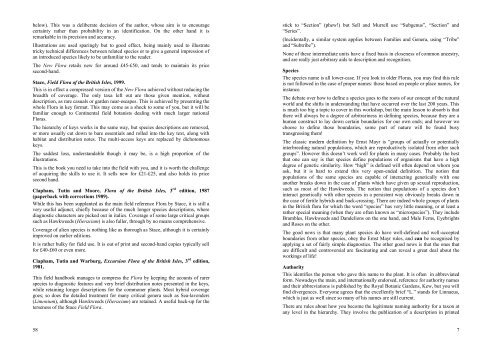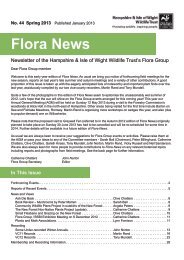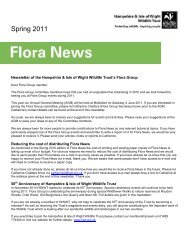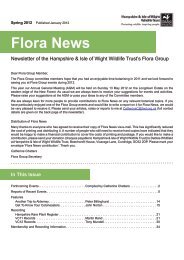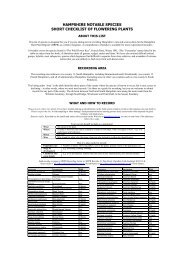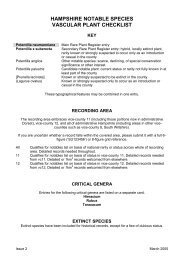An A5 booklet version as distributed in the - Hants Plants
An A5 booklet version as distributed in the - Hants Plants
An A5 booklet version as distributed in the - Hants Plants
Create successful ePaper yourself
Turn your PDF publications into a flip-book with our unique Google optimized e-Paper software.
elow). This w<strong>as</strong> a deliberate decision of <strong>the</strong> author, whose aim is to encourage<br />
certa<strong>in</strong>ty ra<strong>the</strong>r than probability <strong>in</strong> an identification. On <strong>the</strong> o<strong>the</strong>r hand it is<br />
remarkable <strong>in</strong> its precision and accuracy.<br />
Illustrations are used spar<strong>in</strong>gly but to good effect, be<strong>in</strong>g ma<strong>in</strong>ly used to illustrate<br />
tricky technical differences between related species or to give a general impression of<br />
an <strong>in</strong>troduced species likely to be unfamiliar to <strong>the</strong> reader.<br />
The New Flora retails new for around £45-£50, and tends to ma<strong>in</strong>ta<strong>in</strong> its price<br />
second-hand.<br />
Stace, Field Flora of <strong>the</strong> British Isles, 1999.<br />
This is <strong>in</strong> effect a compressed <strong>version</strong> of <strong>the</strong> New Flora achieved without reduc<strong>in</strong>g <strong>the</strong><br />
breadth of coverage. The only taxa left out are those given mention, without<br />
description, <strong>as</strong> rare c<strong>as</strong>uals or garden near-escapes. This is achieved by present<strong>in</strong>g <strong>the</strong><br />
whole Flora <strong>in</strong> key format. This may come <strong>as</strong> a shock to some of you, but it will be<br />
familiar enough to Cont<strong>in</strong>ental field botanists deal<strong>in</strong>g with much larger national<br />
Flor<strong>as</strong>.<br />
The hierarchy of keys works <strong>in</strong> <strong>the</strong> same way, but species descriptions are removed,<br />
or more usually cut down to bare essentials and rolled <strong>in</strong>to <strong>the</strong> key text, along with<br />
habitat and distribution notes. The multi-access keys are replaced by dichotomous<br />
keys.<br />
The saddest loss, understandable though it may be, is a high proportion of <strong>the</strong><br />
illustrations.<br />
This is <strong>the</strong> book you need to take <strong>in</strong>to <strong>the</strong> field with you, and it is worth <strong>the</strong> challenge<br />
of acquir<strong>in</strong>g <strong>the</strong> skills to use it. It sells new for £21-£25, and also holds its price<br />
second hand.<br />
Clapham, Tut<strong>in</strong> and Moore, Flora of <strong>the</strong> British Isles, 3 rd edition, 1987<br />
(paperback with corrections 1989).<br />
While this h<strong>as</strong> been supplanted <strong>as</strong> <strong>the</strong> ma<strong>in</strong> field reference Flora by Stace, it is still a<br />
very useful adjunct, chiefly because of <strong>the</strong> much longer species descriptions, where<br />
diagnostic characters are picked out <strong>in</strong> italics. Coverage of some large critical groups<br />
such <strong>as</strong> Hawkweeds (Hieracium) is also fuller, through by no means comprehensive.<br />
Coverage of alien species is noth<strong>in</strong>g like <strong>as</strong> thorough <strong>as</strong> Stace, although it is certa<strong>in</strong>ly<br />
improved on earlier editions.<br />
It is ra<strong>the</strong>r bulky for field use. It is out of pr<strong>in</strong>t and second-hand copies typically sell<br />
for £40-£60 or even more.<br />
Clapham, Tut<strong>in</strong> and Warburg, Excursion Flora of <strong>the</strong> British Isles, 3 rd edition,<br />
1981.<br />
This field handbook manages to compress <strong>the</strong> Flora by keep<strong>in</strong>g <strong>the</strong> acounts of rarer<br />
species to diagnostic features and very brief distribution notes presented <strong>in</strong> <strong>the</strong> keys,<br />
while reta<strong>in</strong><strong>in</strong>g longer descriptions for <strong>the</strong> commoner plants. Most hybrid coverage<br />
goes; so does <strong>the</strong> detailed treatment for many critical genera such <strong>as</strong> Sea-lavenders<br />
(Limonium), although Hawkweeds (Hieracium) are reta<strong>in</strong>ed. A useful back-up for <strong>the</strong><br />
terseness of <strong>the</strong> Stace Field Flora.<br />
58<br />
stick to “Section” (phew!) but Sell and Murrell use “Subgenus”, “Section” and<br />
“Series”.<br />
(Incidentally, a similar system applies between Families and Genera, us<strong>in</strong>g “Tribe”<br />
and “Subtribe”).<br />
None of <strong>the</strong>se <strong>in</strong>termediate units have a fixed b<strong>as</strong>is <strong>in</strong> closeness of common ancestry,<br />
and are really just arbitrary aids to description and recognition.<br />
Species<br />
The species name is all lower-c<strong>as</strong>e. If you look <strong>in</strong> older Flor<strong>as</strong>, you may f<strong>in</strong>d this rule<br />
is not followed <strong>in</strong> <strong>the</strong> c<strong>as</strong>e of proper names: those b<strong>as</strong>ed on people or place names, for<br />
<strong>in</strong>stance.<br />
The debate over how to def<strong>in</strong>e a species goes to <strong>the</strong> roots of our concept of <strong>the</strong> natural<br />
world and <strong>the</strong> shifts <strong>in</strong> understand<strong>in</strong>g that have occurred over <strong>the</strong> l<strong>as</strong>t 200 years. This<br />
is much too big a topic to cover <strong>in</strong> this workshop, but <strong>the</strong> ma<strong>in</strong> lesson to absorb is that<br />
<strong>the</strong>re will always be a degree of arbitrar<strong>in</strong>ess <strong>in</strong> def<strong>in</strong><strong>in</strong>g species, because <strong>the</strong>y are a<br />
human construct to lay down certa<strong>in</strong> boundaries for our own ends; and however we<br />
choose to def<strong>in</strong>e those boundaries, some part of nature will be found busy<br />
transgress<strong>in</strong>g <strong>the</strong>m!<br />
The cl<strong>as</strong>sic modern def<strong>in</strong>ition by Ernst Mayr is “groups of actually or potentially<br />
<strong>in</strong>terbreed<strong>in</strong>g natural populations, which are reproductively isolated from o<strong>the</strong>r such<br />
groups”. However this doesn’t work well for plants <strong>in</strong> many c<strong>as</strong>es. Probably <strong>the</strong> best<br />
that one can say is that species def<strong>in</strong>e populations of organisms that have a high<br />
degree of genetic similarity. How “high” is def<strong>in</strong>ed will often depend on whom you<br />
<strong>as</strong>k, but it is hard to extend this very open-ended def<strong>in</strong>ition. The notion that<br />
populations of <strong>the</strong> same species are capable of <strong>in</strong>teract<strong>in</strong>g genetically with one<br />
ano<strong>the</strong>r breaks down <strong>in</strong> <strong>the</strong> c<strong>as</strong>e of plants which have given up sexual reproduction,<br />
such <strong>as</strong> most of <strong>the</strong> Hawkweeds. The notion that populations of a species don’t<br />
<strong>in</strong>teract genetically with o<strong>the</strong>r species <strong>in</strong> a persistent way obviously breaks down <strong>in</strong><br />
<strong>the</strong> c<strong>as</strong>e of fertile hybrids and back-cross<strong>in</strong>g. There are <strong>in</strong>deed whole groups of plants<br />
<strong>in</strong> <strong>the</strong> British flora for which <strong>the</strong> word “species” h<strong>as</strong> very little mean<strong>in</strong>g, or at le<strong>as</strong>t a<br />
ra<strong>the</strong>r special mean<strong>in</strong>g (when <strong>the</strong>y are often known <strong>as</strong> “microspecies”). They <strong>in</strong>clude<br />
Brambles, Hawkweeds and Dandelions on <strong>the</strong> one hand, and Male Ferns, Eyebrights<br />
and Roses on <strong>the</strong> o<strong>the</strong>r.<br />
The good news is that many plant species do have well-def<strong>in</strong>ed and well-accepted<br />
boundaries from o<strong>the</strong>r species, obey <strong>the</strong> Ernst Mayr rules, and can be recognised by<br />
apply<strong>in</strong>g a set of fairly simple diagnostics. The o<strong>the</strong>r good news is that <strong>the</strong> ones that<br />
are difficult and controversial are f<strong>as</strong>c<strong>in</strong>at<strong>in</strong>g and can reveal a great deal about <strong>the</strong><br />
work<strong>in</strong>gs of life!<br />
Authority<br />
This identifies <strong>the</strong> person who gave this name to <strong>the</strong> plant. It is often <strong>in</strong> abbreviated<br />
form. Nowadays <strong>the</strong> ma<strong>in</strong>, and <strong>in</strong>ternationally endorsed, reference for authority names<br />
and <strong>the</strong>ir abbreviations is published by <strong>the</strong> Royal Botanic Gardens, Kew, but you will<br />
f<strong>in</strong>d divergences. Everyone agrees that <strong>the</strong> excellently brief “L.” stands for L<strong>in</strong>naeus,<br />
which is just <strong>as</strong> well s<strong>in</strong>ce so many of his names are still current.<br />
There are rules about how you become <strong>the</strong> legitimate nam<strong>in</strong>g authority for a taxon at<br />
any level <strong>in</strong> <strong>the</strong> hierarchy. They <strong>in</strong>volve <strong>the</strong> publication of a description <strong>in</strong> pr<strong>in</strong>ted<br />
7


